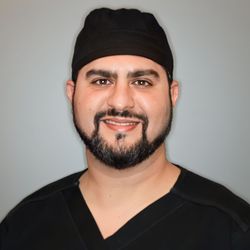Your gingiva (aka “gums”) are the delicate tissues that wrap around your teeth and the supporting bone structures. As mucous membranes, your gums are highly responsive to stimuli and bacteria. They’re also loaded with blood vessels. If your gums are infected, they can appear red, swollen, and tender to the touch.
There’s a lot that your mouth can say about your overall health. So, if you’re having issues with your gums, take note. You might be surprised at what you’ll learn from them.
1. Is Gum Recession Normal?
Healthy gums don’t pull away from teeth. If you’re beginning to notice signs of gum recession and exposed tooth roots, speak with our doctors at PCE right away.
Although gum disease is the most serious cause of gum recession, there are occasionally other risk factors that might contribute to the anomaly, such as: orthodontic treatment, nail biting or other habits, aggressive toothbrushing, etc.
Fortunately, intercepting periodontal disease during the earliest stages can help you avoid additional gum recession. And in some cases, gingival grafting with our periodontal therapist can re-cover the area so that the tooth isn’t exposed at all!
2. What Happens When Gums Shrink/Recede?
Being “long in the tooth” isn’t a rite of passage into the golden years of retirement. Rather, it’s a side-effect of gum recession.
Gum recession is when the soft gingival tissues creep back, revealing the roots of teeth. It’s the result of abrasion and trauma (such as aggressive toothbrushing) or gum disease. In the latter, the periodontal infection causes infected gums to gradually pull away from the tooth because of chronic bacterial accumulation (plaque and tartar.)
Exposed tooth roots don’t just jeopardize the stability of your teeth. Since they aren’t protected by a thick layer of enamel, they’re also at a higher risk of rampant tooth decay and sensitivity.
3. What Does Gum Health Have to do with Dental Implants?
Gum tissues are part of the “glue” that hold your teeth in place. Without them, your teeth would be at risk for sensitivity, tooth decay, and mobility.
Around each tooth, the gums attach across the root via connective tissues and ligaments. This “periodontal ligaments” or “PDL” extends down further onto the root’s surface, attaching your tooth to the bone around it.
When the soft gingival and ligament tissues become infected, they automatically begin detaching from the tooth. The process doesn’t happen overnight, but it’s a gradual and consistent process that may occur over months and years.
When periodontal infections go untreated, your gum condition transitions from a mild case of gingivitis into full-blown tooth loss throughout your mouth.
Watching for the early signs of gum disease and working with a periodontist can help you save your smile.
4. Do Gum Levels Impact My Jaw Bone?
When you think about the health of your teeth, you may not give a lot of thought to the structure of your jaw. But if it weren’t for healthy bone, there would be nothing to keep your teeth stable!
Conditions like gum disease can actually cause bone shrinkage — or “resorption” — and shorter bone levels around your teeth. The disease affects upper and lower teeth alike. And once bone is lost because of an infection, it doesn’t come back. That’s why procedures such as augmentation (bone grafting) play a crucial role in tooth preservation.
It’s worth mentioning that bone and tooth loss also changes the shape and profile of your face. When bone shrinks, it can cause your facial features to look sallow or sunken-in, making you appear older than you really are.
If you’re exhibiting signs and symptoms of gum disease, such as swollen tissues or bleeding when you floss, it’s important to get periodontal treatment right away. Our periodontist in The Woodlands and Conroe offers a variety of therapies to combat periodontitis and associated bone loss.
5. Gum “Pockets”: What Are They?
Around each tooth is a “sulcus” just under the edge of the gum tissues. The sulcus is the 1-3mm deep area that’s created between your tooth and the unattached gingiva that wraps around it. You can think of it like a little trench around each tooth.
When gum tissues start to detach from your tooth, it creates a deeper “periodontal pocket”. Any sulcus that’s deeper than 3mm is considered an unhealthy gum pocket. However, shallower pockets between 0-3mm are considered healthy or normal.
Why does any of this matter? Because gum pockets that are deeper than 3mm indicate that there’s a deterioration of supporting bone and gingival tissues around your tooth. Those structures are essential for keeping your teeth intact! Deep pockets are also impossible to clean with your toothbrush and floss, as those hygiene aids cannot physically reach the plaque bacteria that have settled down into the bottom. At that point, only your dental team can help.
An untreated gum pocket will gradually worsen over time. Left alone, this periodontal infection can lead to bone and tooth loss.
6. Is it Normal for My Gums to Bleed?
Don’t ignore bleeding gums. If you notice “pink in the sink” each time you brush and floss, it’s not normal or healthy. Even if the problem seems to run in your family, having bleeding gums means something more serious is going on with your smile.
The great news is that gum bleeding is reversible. If you catch it early enough — before periodontal disease kicks in — you can typically turn the bleeding around within two weeks of thorough brushing and flossing. If symptoms don’t improve, make sure you see our periodontist for a gum exam and cleaning. Once any tartar and plaque are removed, you’ll have a jump start to get your oral health back on track.
It’s worthwhile to mention that people who smoke may not see bleeding, even if there is a gum infection present. Scheduling regular dental checkups can help you intercept serious issues before your smile is at risk of tooth loss.
7. Why Do Gums Bleed?
Your gum tissues are highly vascular. Even a tiny bump to your mouth can lead to bleeding gums. But if your gingiva seems to bleed when something as simple as brushing or flossing is involved, it usually means you have some type of an infection.
By rushing antibodies via your bloodstream to the gum infection, your body is trying to get the bacteria to go away. But as a side effect, the immune process also leads to tenderness, swelling, and detached gum tissues (so that the antibodies can access the germs.)
In some cases, medical conditions or hormonal changes can contribute to gum bleeding.
Don’t ignore bleeding gums. Make sure you speak to your dental provider or a specialist to get to the root of the issue before more damage is done to your smile.
8. How Can I Get My Gums to Stop Bleeding?
Gum tissues usually bleed because of trauma or infection. If there’s a cavity or food wedged against the gums in a specific area, you might notice bleeding when you brush and floss.
But usually, bleeding gums are a sign of active gum disease (which can range from mild gingivitis to aggressive periodontitis.) To get it to stop, you have to re-vamp your oral hygiene routine entirely. Pay careful attention to brush along your gumlines thoroughly, at least twice a day. Investing in an electric toothbrush can help. Additionally, floss around each tooth at least once per day.
After two weeks, bleeding caused by gingivitis should reverse. If it doesn’t, you might have a more aggressive form of gum disease. At that point you would need to see a dentist or our periodontitis in The Woodlands for a thorough cleaning to remove the bacteria below your gum tissues.
Therapeutic gum care and continued maintenance can stop bleeding and prevent it from coming back.
9. What Does Flossing Have to do with My Gums?
You’ve been told your whole life to brush your teeth twice a day. For a lot of people, the health of their gums isn’t a serious concern until their hygienist tells them that they have gingivitis or gum disease. But even then, a gum infection doesn’t seem serious until the teeth are actually mobile.
You might think that flossing is for preventing cavities between your teeth. It is. But it’s also for cleaning just under your gumlines, where a toothbrush can’t reach. Especially in the areas between your teeth, which are the locations that are at the highest risk of periodontal disease.
When you’re flossing, you physically disrupt the bacterial plaque under your gum tissues (that is, if you’re flossing properly) before it has a chance to infect them or calcify into tartar. Skipping the floss for a day or two means that plaque has already calcified into a thin layer or dental calculus. Over time, this buildup will become cumulative and destructive to the tissues around it.
Flossing helps to extend your oral health between professional dental cleanings. It won’t remove tartar, but it will prevent it from forming in the first place!
10. Can a Periodontist Get My Gums to Grow Back?
Gum disease, toothbrush abrasion, and other causes of gum recession can leave teeth exposed and sensitive. You might be asking whether it’s possible to get the gingival tissues to grow back naturally.
Unfortunately, re-growing gums isn’t physically possible. But the good news is that periodontists can help to re-cover exposed teeth by adjusting or grafting new gum tissues over them. That way you’re replacing lost tissue levels, even when growing gum tissue back isn’t an option.
With gum pockets, we also see a phenomenon where gingival tissues detach from teeth and lead to bone loss around the roots. This infection creates a deep pocket that houses bacterial deposits. There are some studies that show laser treatment therapies can stimulate gum reattachment in the bottom of pockets, causing gums to fuse back to the tooth surface.
11. What is Laser Gum Treatment?
There are several types of dental lasers used today. Some are for treatments like drill-free fillings or cold sore treatments. Others are for performing soft tissue therapies on gum disease or adjusting the shape and contour of your gingival tissue.
Depending on which provider you’re seeing, a gum specialist may incorporate lasers into treatments for periodontal disease.
Lasers are gentle and safe enough to destroy bacteria, speed healing, and protect the healthy tissues around the treatment area. The laser itself only takes a few seconds to work as it harvests light energy to eradicate disease-causing cells that are within the range of the beam.
Opting for laser gum treatments provides a gentler experience with minimal inflammation. That way you can see faster, comfortable results following your oral surgery.
The Woodlands periodontist uses dental lasers for pocket decontamination, periodontal plastic surgery, and other common gum treatments. It’s safe and effective enough that we prefer it over conventional gum surgeries.
12. How do Gingivectomies Work?
Tonsillectomy, appendectomy…you-name-it-ectomy. This common surgical technique is one that specialists use to remove diseased or problematic tissues. In the case of your oral health, a gingivectomy is one example.
A gingivectomy is when your periodontist, dentist, or oral surgeon removes gum tissues in certain areas of your mouth. There are a number of reasons why the procedure may be recommended, such as:
- Gum overgrowth (hyperplasia)
- Gummy smile treatments
- Crown lengthening
- Pocket reduction
- Cosmetic recontouring
- Hormonal or medication-induced hyperplasia
Having your dental expert adjust your gingival tissues can reveal a larger area of tooth and establish consistent gumlines throughout your mouth. Depending on the provider you’re using, they may choose to use a traditional surgical approach or a streamlined procedure using lasers.
Gingivectomies are permanent, so unless your gums are at risk of flaring up from medications and hormones, the procedure will leave you with long-lasting results.
13. Are Gum Grafts Effective?
A gum graft is a procedure where we re-cover an exposed tooth in an area where the gingival tissues have — for some reason or another — receded. Without the protective tissues over it, the tooth is exposed and at a higher risk of sensitivity and decay. Plus, the bone structures underneath will also shrink back due to a lack of coverage.
Grafting is an effective way to halt unnecessary bone loss, erase tooth sensitivity, and stabilize teeth. Without the right coverage, a tooth is at a higher risk of mobility or falling out altogether.
But grafts are only effective if you care for them properly. As the tissues heal, it’s extremely important to allow for minimal irritation or infection. Otherwise, the graft could fail.
For best results, work with a periodontal specialist in The Woodlands, who offers a variety of grafting techniques and has years of experience in gum therapy.
14. Will Smoking Change Your Gums?
Yes. Most people don’t realize they have gum health problems while they’re smoking, because their gingival tissues actually look healthy. They’re usually smooth, without any visible redness or swelling.
But looks can be deceiving, especially if you’re a smoker. Even though your gum tissues might appear healthy, there could be serious periodontal disease lurking underneath them. While a non-smoker will see the warning signs of bleeding and red gums, smokers do not. So, if they’re starting to lose attachment around the roots of their teeth, they may never realize that there is a periodontal infection until teeth feel loose.
Your dental professional will advise you to give up smoking and other tobacco or inhaled products. But to make sure you don’t have gum disease hiding right there in front of you, be sure to schedule a regular checkup and periodontal evaluation with your dental team at least twice a year.
15. If You’re Anemic, do Your Gums Look Different?
People who are iron-deficient or anemic may see some of the first signs inside of their mouth! Gums may appear smooth and healthy, but bleed easily when you brush and floss. Additionally, gingiva may look lighter in color than normal, indicating an absence of red blood cells.
Other symptoms of anemia include warning signs like fatigue, lightheadedness, and brittle nails.
If you suspect that you have an iron deficiency, check your nutrient intake.
Getting plenty of leafy green vegetables like spinach, or red meat (yes, here’s your excuse to eat steak) can help to replenish your body’s red blood cells. Your medical doctor may also recommend a daily iron supplement or multivitamin.
Monitor your gum healthy as you adapt your diet for anemia. If you see color return to your gums, and no signs of bleeding when gums appear otherwise healthy, it could be a “preview” that you’re on the road to recovery.
16. Should Gums Always be Pink or Coral Colored?
A majority of people — regardless of their ethnicity and natural skin tone — have gingiva that are light pink or coral in color. However, there are always exceptions to the rule. Some individuals with especially dark melanin pigments in their skin may see gum tissues that are dark brown.
It’s not uncommon to see a combination of both pink and brown spots or speckling across your gums, depending on your ethnicity.
However, gum tissues do not change color over time. If you’re beginning to notice an area that appears different from the tissues around it, it’s important to schedule an exam with your dental specialist. In rare cases, gingival anomalies may be a sign of precancerous or diseased tissue.
If you personally feel that uneven pigmentation in your gums detracts from your smile’s aesthetic appeal, you have options. By working closely with your dentist or periodontist, you can determine if a cosmetic procedure known as “cosmetic gum bleaching” can help to even-out the pigmentation so that your gums look consistent from one side of your smile to the other.
17. Do Hormone Changes Make Your Gums Tender?
They can. In fact, it’s not uncommon for women to experience symptoms of gingivitis during pregnancy or menses. In the majority of cases, the swelling and tenderness subsides once their hormone levels stabilize again, such as at the end of their cycle or following childbirth.
In more rare scenarios, a condition known as “pregnancy tumors” can appear next to the teeth. These bulbous growths are not true tumors the way we think of them, but a temporary overgrowth of gingiva that’s associated with the hormonal changes during gestation. Again, most of these “tumors” tend to subside after the mother gives birth to her child. If they’re problematic enough to interfere with eating, oral hygiene, or cause self-consciousness, our periodontist can safely remove them.
It’s important to not assume that gingivitis symptoms are due to hormones, dismissing gum swelling between cycles. Undiagnosed and untreated gum disease that isn’t related to hormones can ultimately lead to tooth loss.
18. What Medications Cause Gum Swelling?
Always let your dentist know what medications or supplements you’re taking. It doesn’t matter if they’re prescription or over-the-counter. Why? Because certain types of drugs — including recreational ones — can physically change your gum tissues.
Most people are familiar with dry mouth (xerostomia) being a side effect of certain drugs. But there are other side-effects you should look for too. For example, anti-seizure medications, immunosuppressants, and blood pressure drugs that are “calcium channel blockers” can all cause an overgrowth of gum tissues. It looks like swelling, but it’s actually an expansion of your gingiva that’s triggered by medication.
Why does any of this matter? Because hyperplasia — or gum overgrowth — can mimic or mask symptoms of periodontal disease. Plus, the extra tissues create a pseudo-pocket around teeth, making it harder to clean around them. In rare situations, our periodontist may need to perform a gingivectomy to remove excess gum tissues.
Need to See a Gum Specialist?
Our doctors at PCE have over 30 years of experience as a gum health and implant expert. Our practices serve people throughout The Woodlands and Conroe. So, whether you’re looking to overcome a history of gum disease or hope to restore your smile with a same-day dental implants experience, he’s the specialist to trust.
Contact our periodontal and implant specialist today to request an appointment.
Office Hours
MON - THU8:00 am - 5:00 pm
FRI8:00 am - 2:00 pm
SAT - SUNClosed
Office Hours
MON - THU8:00 am - 5:00 pm
FRI8:00 am - 2:00 pm
SAT - SUNClosed














